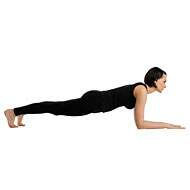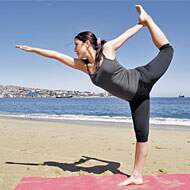- Sun Salutation
- Headstand
- Inverted Triangle Pose
- Hand to Foot Pose
- Lion Pose
- Head to One Knee Pose
- Head to Knees Pose
- Camel Pose
- Sage Marichi Twist Pose
- Half Lord of the Fish Pose
- Inverted Leg Stretch Pose
- Shoulder Stand
- Plough Pose
- Inclined Plane
- Boat Pose
- Fish Pose
- Wheel Pose
- Bridge Pose
- Downward Facing Dog Pose
- Cobra Pose
- Bow Pose
- Locust Pose
- Eagle Pose
- Peacock Pose
- Crow Pose
- Corpse Pose
- Yoga Balance Asanas
- Yoga Asanas For Spine
- Yoga Asanas in Chair
- Basic Yoga Asanas For Stomach
- Yoga Asanas For The Neck
- Yoga Asanas For Depressed
- Yoga Asanas For Beginners
- Sequencing Yoga Asanas
- One Legged King Pigeon Pose - Eka Pada Rajakapotasana
- Reclining Bound Angle Pose - Supta Baddha Konasana
- Eight Angle Pose - Astavakrasana
- Hand Clenching
- Side Crane Pose - Parsva Bakasana
- Ankle Rotation
- Circle pose - Mandalasana
- Half Frog Pose - Ardha Bhekasana
- Four-Limbed Staff Pose - Chaturanga Dandasana
- Extended Puppy Pose - Uttana Shishosana
- Supported Headstand - Salamba Sirsasana
- Pendant Pose - Lolasana
- Shoulder-Pressing Pose - Bhujapidasana
- Ankle Bending
- Wrist Bending
- Standing Half Forward Bend
- Side-Reclining Leg Lift
- Standing Yoga Seal
- Shiva Twist
- Upward Salute
- Intense Side Stretch Pose
- Wild Thing
- Great Hand Posture
- Upward Bow
- Warrior Seal
- Spread Leg Forward Fold
- Legs-Up-the-Wall Pose
- King Pigeon Pose
- Arm Pressing Posture
- Upward-Facing Dog
- Crocodile Pose
- Feathered Peacock Pose
- Reclining Angle Pose
- Reclining Hero Pose
- Half Headstand Pose
Therapeutic Applications Of Dolphin Plank Pose
The Dolphin Plank pose is a judicious mix of the Dolphin Pose and the Plank Pose. This yoga asana aims at improving arm balance, though the aspect of developing core strength is also met by performing this exercise.
Strengthening is done right from the arms all the way to the legs, and your body is benefited by improved muscle tone.
Steps :
- Get down on the floor on your hands and knees. Next, bring your elbows down to the floor, while your palms stay firmly grounded. As you do so, raise your hips toward the ceiling.
- Your legs should be straight, your forearms should rest flat on the ground, your head should be between your elbows, resting on the ground, and your palms should be flat on the ground in front of your head. Your body should take the shape of a triangle.
- Look down on the floor and remain in this pose for 30 to 60 seconds. Then, gradually exhale and let your knees touch the ground.
Precautions :
- This should be exercised if the person performing the exercise has had any shoulder or hip injury.
- In the case of any medical condition, yoga asanas should be tried out only under the supervisions of a skilled expert and after consultation with a doctor.
Beginner's Tip :
As a beginner's tip for Dolphin Plank Pose, use a pillow between your forearms. This will alleviate any pain or injury to the muscles of the neck.
Benefit To Body Part :
- It relaxes the body and mind and is an effective de-stressing exercise.
- It provides a good stretch to all the muscles of the body from the shoulders to the legs. This also results in enhanced muscle tone.
- Dolphin Plank Pose is an excellent exercise for those who wish to build strength in their arms, shoulders, and abdomen.
Therapeutic Applications :
- Preventing the chances of onset of osteoporosis is one of the therapeutic applications of the Dolphin Plank Pose
- This yoga asana also heals mild depression as it soothes and releases a sense of calm in the whole being.
Variations :
- For those who are just beginning yoga, you can keep your knees on the ground so as to perform a Half Dolphin Plank Pose. This is also done in case the arms cannot support the weight of the entire body.
- One leg may also be raised with the heel pointing toward the ceiling. Stay in this position for a few breaths and then return to the original position. A greater degree of strength from this exercise may be experienced when you try to get into the Dolphin Plank Pose from this posture.
Preparatory Poses :
Since this is a standard plank pose and is often a preparatory pose for other more strenuous exercises, there are no preparatory poses for the Dolphin Plank Pose. However, one could perform the simple Plank Pose before getting into the Dolphin Plank Pose.
- Plank pose: Since the Dolphin Plank Pose is a variation of the Plank Pose that lends strength to the entire body, it is good to perform the Plank Pose as a preparatory asana. In the Plank Pose, the whole body stretches out like a plank of wood with the body balanced on the toes and wrists only.
Follow Up Poses :
There aren't many follow up poses for the Dolphin Plank Pose; however, some yoga instructors suggest performing the Locust Pose.
- Locust Pose (Salabhasana) : In the Locust Pose, the arms are stretched outward and the body is balanced on the muscles of the abdomen. This is a good follow up to an exercise that stretches and strengthens the arms.



